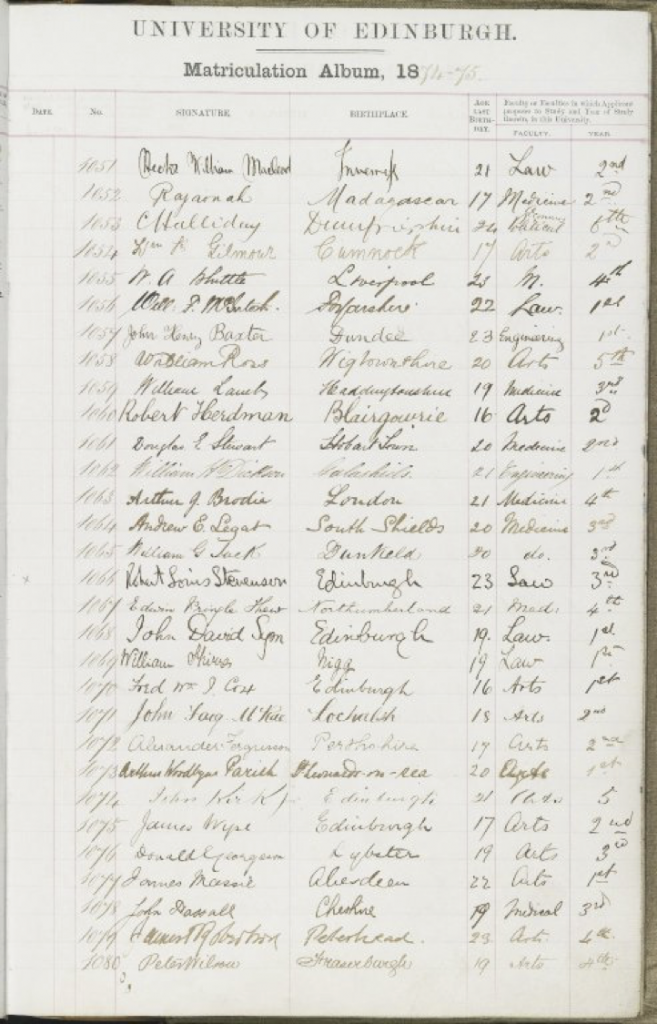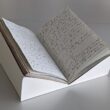Home University of Edinburgh Library Essentials
December 15, 2025
P6 Visitors from St Mary’s Primary
Posted on January 5, 2015 | in Featured, Library | by Stuart LewisA few weeks ago the Library hosted two visits from the two P6 classes of St Mary’s school. Their topic was “Scotland’s Timeline” (I can interpret historical evidence from a range of periods to help to build a picture of Scotland’s heritage and my sense of chronology SOC2-02a) and were studying Kidnapped by Robert Louis Stevenson in order to find out more about Edinburgh and Scotland in the eighteenth century. As Robert Louis Stevenson was a graduate of the University of Edinburgh, this made a good starting point for their visit.

The Matriculation Album of 1874, showing Robert Louis Stevenson’s signature as he entered the 3rd year of his Law degree (he originally studied Engineering when he first joined the University)
As well as seeing a matriculation album with Robert Louis Stevenson’s signature, they examined an early copy of Kidnapped, some of source materials that were used as background for the book, the Barker panorama of Edinburgh, and Münster’s Cosmographia, by Elizabeth Quarmby Lawrence, the Library’s Assistant Rare Books Librarian.
Following this, they enjoyed a workshop led by Sarah Deters, our Learning and Engagement Curator. The workshop examined the development of bagpipes over time, and concluded with an exercise to turn a straw into a playable reed!
The children kindly wrote thank you letters for us, saying which parts of the visit they most enjoyed, and added a few extra questions. Rather than replying directly to the class, we thought we’d share the great questions and answers on this blog…
| Question | Answer |
| How old is the library? | The Library building that you visited is known as the Main Library. It was opened in 1967. However the University’s main Library service has operated from other buildings in the past, such as the Playfair Library which is part of the Old College building, built in 1827. The Library service dates back to 1583 when the University was opened, although the first collection of books was donated in 1580 by Clement Litill. |
| Can we visit again? | Yes! You would be very welcome to visit again. The Main Library, along with many other University buildings are open for visitors during the annual Doors Open Day event, whilst special group visits such as yours can be arranged. Please get in touch! The main library also has an exhibition gallery, which is open to the public and has different exhibitions in it all year round. When you visited one exhibition had just finished and the next one not yet started, so you didn’t see it. Look on our web pages to see what’s on. |
| What is your favourite book? | Elizabeth – Mine changes every week! But the Wode Psalter is pretty good, and you can look at it online. |
| What is your favourite instrument? | That is hard to answer! I love the sound of many different instruments, especially the piano and the trumpet, but my favourite instrument in our museum is a beautiful instrument from India. The instrument is shaped like a peacock, but is a type of string instrument called a mayuri. You can see a picture of it here: http://collections.ed.ac.uk/mimed/record/17372 |
| Why do you enjoy old books more than newer books, and which historic authors do you enjoy reading? | I like old books because I am fascinated by what people in the past knew, and how they thought about it. I also love learning about how books were made, and understanding how and why they were printed and bound as they were. This can often tell us almost as much as the text. Reading historical novels was one of the things which made me interested in this sort of thing. When I was young I used to read Rosemary Sutcliffe’s books, which are mostly about the Romans in Britain. Cynthia Harnett is another good one – she used books and objects from the past to get her inspiration, and was very good at explaining how people thought and how things worked. Try ‘The Woolpack’ or ‘A Load of Unicorn’ (which I really like because it is about printing!) |
| What do you like about music? | I like that music is something everyone can enjoy. Whether you sing, listen to music, or play an instrument that is a way of enjoying music. They say that music is a universal language and I think that is a wonderful thing. |
| Did you enjoy us visiting? | We were very glad that you visited. We enjoy explaining what the University does, and the role that the Library plays in University life. We support students as they learn, researcher as they make new discoveries, and the public as they find out more about what the University does. |
| What is the most interesting part of your job? | All of it! One of the most fun things is choosing books to buy – we are sent catalogues by booksellers and go through them looking for things we think fit into the collections and which someone might find interesting and want to study. |
| Why do you have a lot of students at lunch time but not many in the morning? | The Main Library is open from 7:30 in the morning until 2:30 at night. Each day we have over 5,000 people comes through the door. The building starts to get busy at 9am, but more students arrive each hour as lectures finish. 1pm is the busiest hour for people coming into the building. |
| Do you have any harps in the Library? | We do. We have 7 harps that were made in Europe in our collection as well as different types of harps from around the world. These harps from from Africa, Asia, and America. |
| What is the oldest book in the Library? | The oldest printed book is Chinese – ‘Zhou yi zhuan yi da quan’ [Complete commentaries on the Yi Jing], printed in 1440. We have manuscripts (that is books which were written by hand) going back to the 10th century. |
| How did you collect all the books and artifacts? | Some of the books the University has bought – since it was founded in 1580 a lot of the books which were originally ordinary books used by students have become very old and rare. Today the library buys most of its new books for students as e-books, but we do still buy special books for the rare books and manuscripts collections. The other way that books arrive is by being given to the library. When the University was founded, Clement Little, an Edinburgh lawyer, gave the library 276 volumes, to get it started. Lots of other people have given things since. There was also a time, about 200 years ago, when Edinburgh University Library was a “Copyright Deposit Library”, which meant that all British publishers were supposed to give one copy of everything they published. It didn’t work out as well as it sounds, and quite soon was stopped, but we still have a lot of the books. |
| What is the oldest object that you have? | Sarah – the oldest instrument in our collection is a recorder made in 1510. Elizabeth – we have some scraps of papyrus, which are about 2000 years old. |
Stuart Lewis – Deputy Director, Library & University Collections
Serena Fredrick – Student Support Officer
Elizabeth Quarmby Lawrence – Assistant Rare Books Librarian
Sarah Deters – Learning and Engagement Curator
Collections
 Hill and Adamson Collection: an insight into Edinburgh’s past
My name is Phoebe Kirkland, I am an MSc East Asian Studies student, and for...
Hill and Adamson Collection: an insight into Edinburgh’s past
My name is Phoebe Kirkland, I am an MSc East Asian Studies student, and for...
 Cataloguing the private papers of Archibald Hunter Campbell: A Journey Through Correspondence
My name is Pauline Vincent, I am a student in my last year of a...
Cataloguing the private papers of Archibald Hunter Campbell: A Journey Through Correspondence
My name is Pauline Vincent, I am a student in my last year of a...
Projects
 Cataloguing the private papers of Archibald Hunter Campbell: A Journey Through Correspondence
My name is Pauline Vincent, I am a student in my last year of a...
Cataloguing the private papers of Archibald Hunter Campbell: A Journey Through Correspondence
My name is Pauline Vincent, I am a student in my last year of a...
 Archival Provenance Research Project: Lishan’s Experience
Presentation My name is Lishan Zou, I am a fourth year History and Politics student....
Archival Provenance Research Project: Lishan’s Experience
Presentation My name is Lishan Zou, I am a fourth year History and Politics student....

